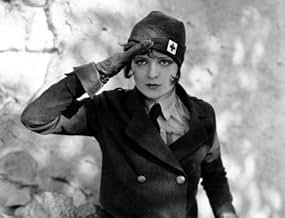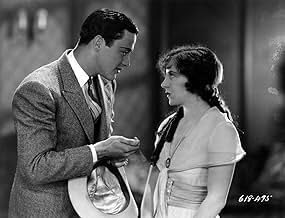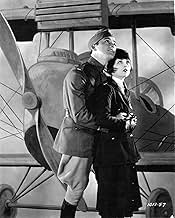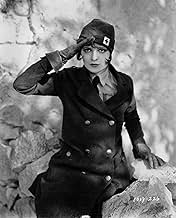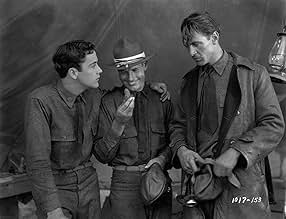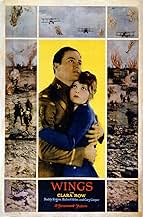IMDb रेटिंग
7.5/10
16 हज़ार
आपकी रेटिंग
अपनी भाषा में प्लॉट जोड़ेंTwo young men, one rich, one middle class, who are in love with the same woman, become fighter pilots in World War I.Two young men, one rich, one middle class, who are in love with the same woman, become fighter pilots in World War I.Two young men, one rich, one middle class, who are in love with the same woman, become fighter pilots in World War I.
- 2 ऑस्कर जीते
- 9 जीत और कुल 1 नामांकन
Charles 'Buddy' Rogers
- Jack Powell
- (as Charles Rogers)
Charles Barton
- Soldier Flirting with Mary
- (बिना क्रेडिट के)
Thomas Carr
- Aviator
- (बिना क्रेडिट के)
Thomas Carrigan
- Undetermined Role
- (बिना क्रेडिट के)
Margery Chapin
- Peasant Woman
- (बिना क्रेडिट के)
Andy Clark
- Undetermined Role
- (बिना क्रेडिट के)
फ़ीचर्ड समीक्षाएं
My cousin Clifford M. Blackstone Sr. was the person who filmed the flight scenes in this movie. His son Cliff sent me photographs of his Dad filming this movie as well as a few others with Paramount Studios. Cliff said his Dad was put in an airplane and sent up in the air to crank out all those amazing flight scenes. He said his Dad told him he wasn't even secured in the plane. Cliff Blackstone Sr. is from Mercer County, PA and Cliff Jr. says his Dad was the man who created the zoom lens. Just a side bar, Clara Bow, the lead actress in Wings, had a hairdresser Maryl who Clara introduced to Cliff Sr. Cliff Sr. married Maryl and they had Cliff Jr. It is really a nice story.
You could justifiably criticize WINGS lesser moments: the naive, "gee-whiz" dialog...the less than comedic "champagne" sequence in Paris...any of the romantic scenes...the idealized view of military life.... But as light entertainment, WINGS manages to hold its own, despite the passage of years. The battle scenes, easily the highlight of the film, may not have the intensity of later films, but the narrative is clear and precise. And this was not meant to be the last word in documentary accuracy: it's an adventure film tinged with romance, with engaging aerial fight scenes that capture your attention whenever they occur.
And personally, I felt that the music from the Wurlitzer organ tied together the film's various themes, musical and narrative, quite tidily.
And personally, I felt that the music from the Wurlitzer organ tied together the film's various themes, musical and narrative, quite tidily.
The first movie to win the Best Picture Oscar was this terrific WW1 aviation epic from Paramount Pictures and director William Wellman. Charles "Buddy" Rogers stars as Jack Powell, a small town guy who quickly joins up for the Air Corps when the US enters World War One. He's joined by David Armstrong (Richard Arlen), the town rich kid. Both Jack and David are in love with Sylvia Lewis (Jobyna Ralston), although Sylvia only feels the same about David. Top-billed Clara Bow is Mary Preston, Jack's girl-next-door who is secretly in love with him, so much so that she joins the ambulance corps in order to get sent overseas, too. Someone should have pointed out to her just how big France is. Jack and David become close friends in the crucible of war, but life is often short for a fighter pilot.
The aerial photography is truly incredible, and is the real highlight, although the ground warfare scenes are huge in scope and well-choreographed. The performances are all very good. Rogers and Arlen have a real bromance, and both exude star power. Cooper made quite a splash in an early, very small role. Bow is fun, but her scenes almost seem to be from a different movie. The movie also won an Oscar for Best Engineering Effects, a precursor to the special effects award. While this doesn't quite rise to the epic heights of The Big Parade, this is very good, and makes a good companion piece with that film in their depiction of "the Great War". Recommended.
The aerial photography is truly incredible, and is the real highlight, although the ground warfare scenes are huge in scope and well-choreographed. The performances are all very good. Rogers and Arlen have a real bromance, and both exude star power. Cooper made quite a splash in an early, very small role. Bow is fun, but her scenes almost seem to be from a different movie. The movie also won an Oscar for Best Engineering Effects, a precursor to the special effects award. While this doesn't quite rise to the epic heights of The Big Parade, this is very good, and makes a good companion piece with that film in their depiction of "the Great War". Recommended.
Famous of course for winning the first Oscar for best film, WINGS is also one hell of a good film. Spectacular aerial photography highlights the terrific performances of the three leads: Clara Bow, Buddy Rogers, and Richard Arlen. Director William Wellman creates a solid and moving anti-war statement as he shows us the brutality and stupidity of war, its waste of youth, and its power to destroy the lives of all involved.
The film starts with star-crossed lovers in a small town in America. Bow loves Rogers but he loves Jobyna Ralston. Ralston loves Arlen and he loves her but through a mistake, Arlen thinks she loves Rogers. Then the boys go off to war. The outgoing Rogers thinks the war will be an adventure; the shy Arlen goes off, leaving his devastated parents who cannot express their emotions. Bow soon goes off to be an ambulance driver. Ralston stays homes and waits.
The story follows the rivalry and growing friendship of the boys as they head for war. The story ends in yet another bitter mistake. The viewer is as emotionally drained by the end of this film as the parents were at the beginning.
El Brendel provides some comedy relief. Roscoe Karns has a small part. Henry B. Walthall and Julia Swayne Gordon are the parents. And Gary Cooper has one brief scene with Rogers and Arlen. The scene in which he turns and flashes that famous smile as he exits the tent supposedly made him a star.
Clara Bow is solid as the spirited home-town girl who chases Rogers to no avail. She's gorgeous here and she is even moreso in the Paris scene where the matron lets her borrow a snappy and dazzling dress. Few women in film history have been able to be so sexually charismatic as Clara Bow. She's also a good actress.
Richard Arlen and Buddy Rogers give their best performances here. Each takes turns as the center of attention as they become men during the grueling war. Their flight scenes are incredibly well done. Arlen's flight scene as he races toward the American lines is amazing.
Jobyna Ralston has a rare memorable film not working with Harold Lloyd. And Henry B. Walthall is quietly grand as the crippled father.
Wellman's direction and the camera work of Harry Perry are beyond perfection. The aerial battles are breathtaking as are the scenes where they blow up the German blimps. There's also one astounding scene in the beginning of the film where Ralston and Arlen are in a swing. The camera is mounted in a stationary position in front of the actors so we see the scene as though we are in the swing with them. Then suddenly in the background we see Rogers in his jalopy pulling up in the street. The swing stops and Ralston gets out and runs to Rogers (in the background) while we see the close-up of Arlen as he twists in the swing seat and turns to watch them. It's an amazing scene and all one shot.
This film is a must see.
The film starts with star-crossed lovers in a small town in America. Bow loves Rogers but he loves Jobyna Ralston. Ralston loves Arlen and he loves her but through a mistake, Arlen thinks she loves Rogers. Then the boys go off to war. The outgoing Rogers thinks the war will be an adventure; the shy Arlen goes off, leaving his devastated parents who cannot express their emotions. Bow soon goes off to be an ambulance driver. Ralston stays homes and waits.
The story follows the rivalry and growing friendship of the boys as they head for war. The story ends in yet another bitter mistake. The viewer is as emotionally drained by the end of this film as the parents were at the beginning.
El Brendel provides some comedy relief. Roscoe Karns has a small part. Henry B. Walthall and Julia Swayne Gordon are the parents. And Gary Cooper has one brief scene with Rogers and Arlen. The scene in which he turns and flashes that famous smile as he exits the tent supposedly made him a star.
Clara Bow is solid as the spirited home-town girl who chases Rogers to no avail. She's gorgeous here and she is even moreso in the Paris scene where the matron lets her borrow a snappy and dazzling dress. Few women in film history have been able to be so sexually charismatic as Clara Bow. She's also a good actress.
Richard Arlen and Buddy Rogers give their best performances here. Each takes turns as the center of attention as they become men during the grueling war. Their flight scenes are incredibly well done. Arlen's flight scene as he races toward the American lines is amazing.
Jobyna Ralston has a rare memorable film not working with Harold Lloyd. And Henry B. Walthall is quietly grand as the crippled father.
Wellman's direction and the camera work of Harry Perry are beyond perfection. The aerial battles are breathtaking as are the scenes where they blow up the German blimps. There's also one astounding scene in the beginning of the film where Ralston and Arlen are in a swing. The camera is mounted in a stationary position in front of the actors so we see the scene as though we are in the swing with them. Then suddenly in the background we see Rogers in his jalopy pulling up in the street. The swing stops and Ralston gets out and runs to Rogers (in the background) while we see the close-up of Arlen as he twists in the swing seat and turns to watch them. It's an amazing scene and all one shot.
This film is a must see.
Wings (1927)
An epic WWI movie that uses all the classic approaches to a war film and has a lot of great battle footage. It's a tale of rivalry over a girl, of fighting for country (and against the Germans), and of facing death. There are several scenes that make death really gruesome--blood spurting from a pilot's mouth, or a man crushed under a tank--that took me by surprise. I didn't know that such a mainstream American film would go there.
"Wings" is in a way exactly what American movies would look like thereafter--not just war movies, but all of them. By that I don't mean directors studied this movie and it was the inspiration from here on. But just that the story line, the romance, and even the filming, adventurous but straight on, with more attention to characters and plot than visual effect, all of this would be how films would be made for decades. Including many more by the director, William Wellman, who is one of handful of truly expert but never quite daring and inventive directors of classic Hollywood.
To back this up neatly, compare this film to the other film that jointly won Best Picture this year (the first year the Oscars were given, and the only year when the best picture category had two separate parts). That is Murnau's "Sunrise." Never mind which is better ("Sunrise," easily by most accounts). Notice how this film is utterly conservative and "conventional" in its approach to the art of making movies. It's superbly well done, but well within the rules of the time. Yes, there are moments of inspiration, including some double-exposed stock where a scene takes play in the sky over another scene on the ground. But "Sunrise" shows the lyrical art of the camera, and of editing, and of a less literal kind of storytelling. "Wings" is probably much easier to watch for most people--that's the idea. But "Sunrise" is far more engaging and complex, begging you to watch it twice. I doubt anyone needs to see "Wings" a second time.
But then, I have to admit the acting makes more sense in this film. The naturalism of the three leads helps you get emotionally involved. The most famous by far is the woman, Paramount's biggest star, Clara Bow. She doesn't get a huge role (the men do the fighting and flying) but at least when she's there she's a treat. The flying is actually done by the actors, and many of the people involved were veterans (including Wellman, who was a WWI pilot himself).
It's pretty exciting to find this so exciting all these years later. Give it a look. It's been restored really well (there's even a new Blu-Ray release). And it looks great. Don't expect anything new from the story or the filmmaking, but just expect a really well made high drama affair.
An epic WWI movie that uses all the classic approaches to a war film and has a lot of great battle footage. It's a tale of rivalry over a girl, of fighting for country (and against the Germans), and of facing death. There are several scenes that make death really gruesome--blood spurting from a pilot's mouth, or a man crushed under a tank--that took me by surprise. I didn't know that such a mainstream American film would go there.
"Wings" is in a way exactly what American movies would look like thereafter--not just war movies, but all of them. By that I don't mean directors studied this movie and it was the inspiration from here on. But just that the story line, the romance, and even the filming, adventurous but straight on, with more attention to characters and plot than visual effect, all of this would be how films would be made for decades. Including many more by the director, William Wellman, who is one of handful of truly expert but never quite daring and inventive directors of classic Hollywood.
To back this up neatly, compare this film to the other film that jointly won Best Picture this year (the first year the Oscars were given, and the only year when the best picture category had two separate parts). That is Murnau's "Sunrise." Never mind which is better ("Sunrise," easily by most accounts). Notice how this film is utterly conservative and "conventional" in its approach to the art of making movies. It's superbly well done, but well within the rules of the time. Yes, there are moments of inspiration, including some double-exposed stock where a scene takes play in the sky over another scene on the ground. But "Sunrise" shows the lyrical art of the camera, and of editing, and of a less literal kind of storytelling. "Wings" is probably much easier to watch for most people--that's the idea. But "Sunrise" is far more engaging and complex, begging you to watch it twice. I doubt anyone needs to see "Wings" a second time.
But then, I have to admit the acting makes more sense in this film. The naturalism of the three leads helps you get emotionally involved. The most famous by far is the woman, Paramount's biggest star, Clara Bow. She doesn't get a huge role (the men do the fighting and flying) but at least when she's there she's a treat. The flying is actually done by the actors, and many of the people involved were veterans (including Wellman, who was a WWI pilot himself).
It's pretty exciting to find this so exciting all these years later. Give it a look. It's been restored really well (there's even a new Blu-Ray release). And it looks great. Don't expect anything new from the story or the filmmaking, but just expect a really well made high drama affair.
Oscars Best Picture Winners, Ranked
Oscars Best Picture Winners, Ranked
See the complete list of Oscars Best Picture winners, ranked by IMDb ratings.
क्या आपको पता है
- ट्रिवियाWas lost for decades until a copy was discovered languishing in the Cinematheque Francaise film archive in Paris, France.
- गूफ़The film is set during the years 1917-1918, but most of the female civilian clothes and hairstyles are contemporary with the late 1920s, particularly the clothes worn by Clara Bow in the home sequences and in the Folies Bergère sequence. Bow and almost all the other female characters have bobbed hair, common in 1927 but almost non-existent during World War One.
- भाव
Sergeant in Mervale: Hey, if youse guys need kissin' *I'll* kiss you - wit' a gun-butt!
- इसके अलावा अन्य वर्जनSome showings have trimmed Clara Bow's brief topless scene.
- कनेक्शनEdited into The Eagle and the Hawk (1933)
- साउंडट्रैकThe Star Spangled Banner
(credited on 2012 restored score only)
Written by John Stafford Smith & Francis Scott Key
टॉप पसंद
रेटिंग देने के लिए साइन-इन करें और वैयक्तिकृत सुझावों के लिए वॉचलिस्ट करें
- How long is Wings?Alexa द्वारा संचालित
विवरण
बॉक्स ऑफ़िस
- बजट
- $20,00,000(अनुमानित)
- दुनिया भर में सकल
- $1,684
- चलने की अवधि2 घंटे 24 मिनट
- रंग
- ध्वनि मिश्रण
- पक्ष अनुपात
- 1.33 : 1
इस पेज में योगदान दें
किसी बदलाव का सुझाव दें या अनुपलब्ध कॉन्टेंट जोड़ें







